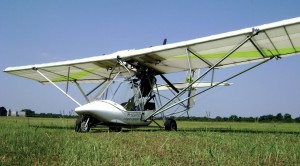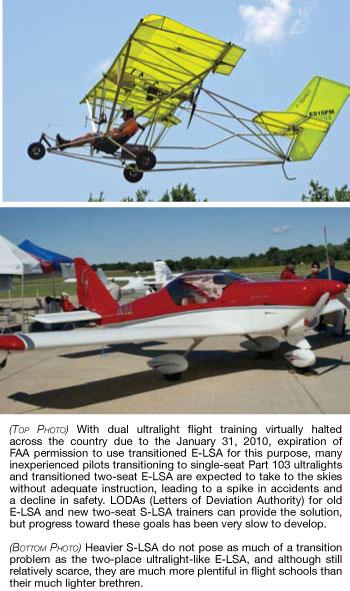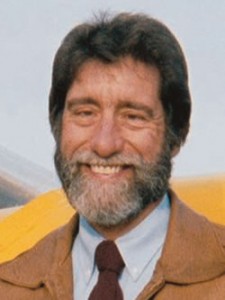Heated Controversy Has Good Arguments On Each Side Don’t Sell Your Old E-LSA Just Yet!
by Ed Leineweber
The poet Robert Burns famously wrote that the best laid schemes of mice and men often go astray. And so it seems, looking at the dust-up now taking place in the Sport Pilot-Light Sport Aircraft world over the continued use of two-seat ultralight Experimental Light Sport Aircraft (E-LSA) for flight training.
Especially in this very light segment of low-mass/high-drag, slow speed aircraft, things just haven’t worked out as envisioned by the drafters of the 2004 rules, and where we go from here remains in doubt. What follows is background information on the controversy, the arguments on both sides, and some suggestions for individual pilots, flight instructors and ultralight E-LSA owners.

Two-seat ultralight trainers with Special-Light Sport Aircraft (S-LSA) airworthiness certificates, like this M-Squared Breese 2, are available on the market for use in ultralight flight training, but have not yet found their way into many flight training operations, leading to pressure on the FAA to continue to permit the use of transitioned E-LSA for flight training through liberal issuance of “Letters of Deviation Authority” (LODAs).
What’s the Problem?
You might recall that a prime purpose of the rules which created the sub-category of Experimental Light Sport Aircraft described in 14 CFR (FAR) section 21.191(i)(1) was to bring into legal status all the “fat ultralights;” that is, two-seat aircraft that were not compliant with the Part 103 ultralight rules. These machines were earlier permitted exemptions for use as trainers, but under the new SP-LSA rules, such continued use would not be permitted. (The widely-known fact is that most of these aircraft where not used for training at all, but were flown for purposes not included in the exemption.)
The vision of the planners of the new Sport Pilot-Light Sport Aircraft movement was that all LSA used for compensation or hire, including flight training, would be factory-built and professionally maintained new aircraft with Special-Light Sport Aircraft (S-LSA) airworthiness certificates. Of course, for this vision to become reality it would be necessary for S-LSA to start populating the training fleet in enough numbers to adequately serve the training demands of students and flight instructors.
Recognizing that this new fleet of S-LSA training aircraft wouldn’t materialize overnight, FAR section 91.319(e) permitted the use of properly registered and newly N-numbered transitioning aircraft, now sporting E-LSA airworthiness certificates, which had been used for flight training prior to the adoption of the SP-LSA rules to continue to be used for flight training by the same owner until January 31, 2010, upon which date the Operating Limitations permitting flight training would expire and further use of the aircraft for flight training would no longer be permitted. It seemed reasonable then to believe that six years would be long enough to get the new S-LSA trainers into service, and for existing trainer owners to get their investment out of their machines and purchase new training aircraft.
Unfortunately, it hasn’t happened that way, especially for ultralight trainers. In many areas of the country very few S-LSA aircraft in this segment have made it to the flight lines of the nation’s flight schools and FBOs. There are many reasons for this, but whatever the cause, the net effect of the expiration of the Operating Limitations training permission for the transitioned E-LSA fleet and the absence of ultralight S-LSA in the field has caused training in the lightest segment of light aviation to virtually come to a halt. A moment’s reflection on this situation will easily bring to mind some pretty significant safety concerns.
These safety concerns arise from the fact that so many pilots who honed their pilot skills in heavier aircraft are transitioning down to this very light aviation segment consisting mostly of low-mass/high-drag aircraft like Quicksilver and Challenger models, which handle very differently than heavier GA aircraft. (Even heavier Light Sport Aircraft like Remos, Flight Design or Evektor models, while exhibiting some of the same transition problems, do not present them to the degree seen in the ultralight segment.) Ample evidence of the nature of this problem began showing up early after the adoption of the SP-LSA rules in accident reports and insurance claims.
While the need for transition training from standard type-certificated aircraft to experimental amateur-built aircraft has been recognized for years, the problem has become more acute with the advent of the Sport Pilot rules and the increasing popularity of low-mass/high-drag ultralight aircraft. Under the present circumstances, people are buying these aircraft and attempting to fly them without professional flight training.
Finally, in response to the problem just described, but further aggravating the problem caused by the expiration of E-LSA flight training permission and the lack of ultralight S-LSA training aircraft, the FAA earlier this year adopted a requirement that Sport Pilots wishing to fly aircraft with a Vh (maximum speed in level flight with maximum continuous power) of 87 knots or less must receive training in such an aircraft and obtain a flight instructor’s endorsement. This training has become nearly impossible to get in most areas of the country.
The Plot Thickens: Letters of Deviation Authority
 Apparently anticipating that there might be a problem with developing an adequate S-LSA training fleet by the January 31, 2010 deadline for the use of E-LSA as trainers, the drafters of the SP-LSA rules included sub-section (h) in FAR section 91.319. It states that the FAA may issue “deviation authority” allowing E-LSA to continue to be used for flight training after the deadline. The document setting forth this permission is known as a “letter of deviation authority” (LODA).
Apparently anticipating that there might be a problem with developing an adequate S-LSA training fleet by the January 31, 2010 deadline for the use of E-LSA as trainers, the drafters of the SP-LSA rules included sub-section (h) in FAR section 91.319. It states that the FAA may issue “deviation authority” allowing E-LSA to continue to be used for flight training after the deadline. The document setting forth this permission is known as a “letter of deviation authority” (LODA).
The LODA process is not new to the FARs and is used in other situations where official permission is granted by the FAA to vary from the requirements of specified regulations. Like many grants of authority by the FAA (e.g. Part 135 air taxi operations, Part 141 flight schools, certified repair stations, PMA approvals), LODAs are only issued following an exhaustive application, documentation and inspection process.
Guidance specific to issuance of LODAs for continued use of E-LSAs for flight training was issued by the agency on September 7, (Change 104 to FAA Order 8900.1), and it appears nobody is happy with what they see. Depending on your perspective, either LODAs for this purpose should not be issued at all, or the flight training activities permitted by the newly-announced guidance is far too restrictive to adequately address the problem. Here are the arguments for each side.
No LODAs; New S-LSA Are Available
Paul L. Mather, president of M-Squared, Inc., makes this argument eloquently and passionately. He points out that the ground rules were set out for everybody at the time of the adoption of the SP-LSA rules. Flight instructors who were teaching in two-seat ultralights knew they had six years to transition to S-LSA aircraft from their E-LSA machines. Investors in the development of new S-LSA to meet the anticipated market demand were induced to rely upon the expiration of the training permission in setting up their business plans.
Mather points out that all transitioned two-place ultralights are now at least six years old, and most are probably much older, dating to the 1980s or ’90s. They have not been required to be maintained to any standard and likely do not have airframe service manuals. Many have component parts, such as cable sets, that have not been replaced according to any known standard, and have old technology parts, such as fuel lines, that are not as safe and reliable as those on current S-LSA.
New S-LSA are now available, Mather argues, at reasonable prices, especially considering the costs which should be associated with bringing an old E-LSA into compliance with the demands of the FAA concerning aircraft condition before issuing a LODA. There is no justification, he asserts, for the FAA to undermine the market for new ultralight S-LSA by ill-advised issuance of LODAs, either from a safety perspective or for economic reasons, and it is fundamentally unfair to companies like his who invested in the development of S-LSA suitable for use in ultralight flight training.
A perhaps less-than-exhaustive search of the industry offerings finds only two companies that have two-seat ultralight-type S-LSA: M-Squared, with its Breese 2 priced in the vicinity of $35,000; and CGS Aviation, with its Hawk Arrow II, carrying a $40,000 price tag, depending upon options, etc.
The other side of the argument goes like this: with no viable ultralight training options available to transitioning pilots and primary students, people will just get into these low-mass/high-drag aircraft and attempt to fly them, with predictable results showing up in the accident statistics. Perfectly good E-LSA, carefully maintained for years by their flight instructor owners, will sit idle, while flight instructors fly with students who purchase their own older ultralight E-LSA, the maintenance history for which is largely unknown and probably deficient.
Further, even if a flight instructor applies for a LODA and jumps through all the hoops, except as discussed in the next paragraph, the deviation authority granted will only be for transition training. And the LODA will expire 24 months after it is issued.
Another twist: Under the terms of the FAA guidance issued on September 7, LODAs will be issued for primary training in E-LSA with an empty weight of less than 500 pounds and a Vh of 87 knots or less only if there is no ultralight-type S-LSA available for flight training anywhere in the geographic area covered by the Flight Standards District Office (FSDO). The net result of this, so the argument goes, is that pilots will be forced to travel long distances to get to available aircraft, and will largely be discouraged from pursuing their flight training.
What’s Next? Wait & See!
Knowledgeable industry insiders, many aviation journalists and EAA itself are generally critical of what they feel is a too-restrictive LODA policy announced by the FAA in September, and they are actively advocating for revisions expanding the circumstances and purposes for which LODAs may be issued. The arguments focus mainly on safety and the need to increase and maintain the number of active pilots. Rumors circulating suggest that the FAA is indeed re-evaluating its policy and might make it more accommodating soon.
On the other hand, safety arguments can be made in support of pushing for the transition to new state-of-the-art S-LSA, manufactured in controlled, quality-assured facilities and maintained according to closely regulated standards by professionally trained maintenance technicians. And the manufacturers who have invested in the facilities, equipment, processes and development costs to produce these new aircraft on the implicit promise that a market would develop with the forced retirement of the transitioned training fleet, have an appealing economic case to make as well.
So what to do? How about holding on to that transitioned E-LSA you were using for flight training back in 2004 while you seriously investigate a new S-LSA for your flight school?











